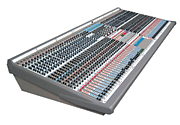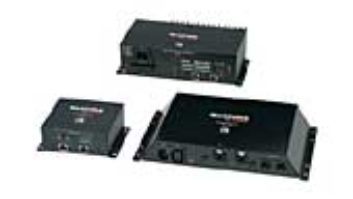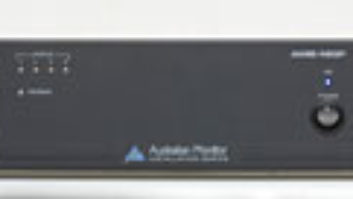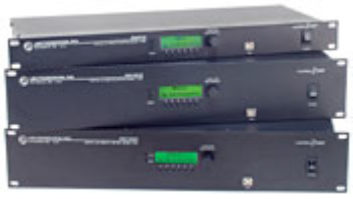
APB DynaSonics Spectra console
Following on the heels of Winter NAMM — just six weeks before — the 25th annual NSCA Expo (March 10 to 12, 2005) didn’t have a lot of new product debuts. However, with 600 exhibitors filling Orlando’s Orange County Convention Center, there was still a lot to see. Here are my picks for the show’s top live sound introductions.
Founded by industry vets Chuck Augustowski, John Petrucelli and Taz Bhogal, new console manufacturer APB DynaSonics (www.apbdynasonics.com) unveiled its Spectra Series analog VCA desks. Designed for touring or fixed installs, the boards include features not often found at this price point, such as Burr-Brown mic pre’s, THAT VCAs, a master output VCA (for controlling any combination of four mix outputs and four matrices), built-in hot-swappable redundant power supplies and LCR control room AFL monitoring. One unique touch is the EQ design, with filters an octave wide in boost and a third wide in cut. Deliveries begin Q3, 2005.
Ashly (www.ashly.com) showed six of its new Protea-enabled PE Series amps, available from 400 to 1,900 W/channel. Housed in a two-rackspace chassis, these 20-pound, switch-mode amps are controllable over Ethernet using Protea software. Optional 32/96kHz DSP cards provide analog or digital inputs and processed outputs for two other amp channels.
Carver Professional (www.carverpro.com) unveiled its new ZRx-3200 amplifier, another switch-mode design, featuring built-in control/monitoring and onboard DSP.

Meyer-M-d-ten.gif
Meyer Sound (www.meyersound.com) expanded its M Series of self-powered line array speakers with the newest compact version, unnamed at press time. (I suggested “Mark.”) Slightly larger than the M2D, it employs all-new high-power components expressly designed for the unit: dual 10s — with one crossed out early — and twin HF drivers. It also includes built-in “balcony bars.”
Roland Systems Solutions (www.RSSAmerica.com), Roland’s new commercial division, showed its AR-3000 single-rackspace digital audio recorder/player. The unit features up to 48kHz sample rates, two PCMCIA memory slots and an IP network option. Also new is the S-3208 Cat-5 24/96 digital snake, which has 20dB pads, phantom power and 55 dB of gain trim on its remote-controllable inputs.
Stardraw‘s Control (www.stardraw.com) generates stand-alone, customized programs that can control addressable gear from any manufacturer over any communications infrastructure. It offers an open, software-based, unified control framework that can manage the entire system with a single application, breaking the constraints of proprietary or closed-architecture systems. Features include a drag-and-drop interface and an intuitive design environment. Protocols currently supported include IP, RS-232, DMX, IR, EtherSound, CobraNet, infrared, UDP, SNMP and QSControl.Net.
First-time NSCA exhibitor Tek Panel (www.tekpanel.com) demoed its 300T, an integrated 30-inch WXGA touchscreen 2.4GHz Pentium 4 computer with CD/DVD-ROM and 125-channel NTSC-TV tuner. Initially developed for military applications, this 42-pound, 5-inch-thick touchscreen PC is also available in two levels of ruggedization said to stop 9mm or 0.45-caliber bullets.

Turbosound Aspect TA-890H
Turbosound (www.turbosound.com) unveiled the TA-890H touring version of its radical Aspect Series full-range enclosure. The unique HF and HMF multicell PolyHorns create a gently curved low-distortion wavefront with 25°×15° dispersion. The 450 to 5k Hz mids are handled by a 10-inch driver, with highs by a 3-inch compression driver and dual long-excursion 10s providing the lows. The compact 31×19×22-inch enclosures’ MF/HF sections can be rotated, and cabinets can be flown in horizontal or vertical orientation with an elegant fly system.
The V-8 and V-10 line array systems from WorxAudio (www.worxaudio.com) offer a self-powered option using its PMD-1 amp module. The 4-foot-wide V-10 uses a pair of vented 10s; between them is the Acoustic Integrating Module (AIM) horn that houses twin 8-inch drivers on the side walls and a 3-inch compression driver. The V-8 is simply the AIM without the 10s and is only 28 inches wide.
Xilica‘s (www.xilica.com) DCP-3060 3×6 cost-optimized speaker-management system employs 24/48kHz converters, featuring 1Hz frequency resolution, six parametric filters for each input/output, multiple crossovers to 48 dB/octave, full-function limiters and 30 program memories. Options include digital I/O and CobraNet.

XTA DP428
XTA‘s (www.xta.co.uk) DP428 is a 4×8 DSP matrix with eight input filters, 28-band graphic EQ, nine output filters, dual-stage limiters and 96kHz AES digital I/O, all in a single rackspace. New AudioCore software features “shadowing” of the selected filter along with the composite curve display. Priced the same as a pair of 224s, the DP428’s memory is compatible with earlier presets.
New Version 2 software for Yamaha’s (www.yamaha.com/proaudio) PM-1D digital console has features such as automatic gain adjustment for shared inputs, load filter for more flexible file management with PCMCIA memory cards and insert/delete channel to improve console setup. Other new features include a fader view display and integration of Yamaha’s add-on effects, including vintage compressors, EQ, REV-X and tape emulation.
Zaxcom (www.theultimatewireless.com) was showing its second-generation TRX900 digital wireless bodypack transmitter with an integrated wireless IFB receiver. One lithium 123 battery provides five hours of operation. Body pack audio gain, RF channel frequency, highpass filter, transmitter RF power and other significant settings are adjustable via remote control from the IFB transmitter module. Ninety minutes of 24-bit audio can be recorded and played back via commands from the IFB transmitter, and it has timecode capability. I’ll be in my trailer.
Mark your calendar for next year when NSCA returns to Las Vegas over St. Paddy’s Day — March 16 to 18, 2006.
Mark Frink ([email protected]) is Mix’s sound reinforcement editor. Ms. k.d. lang has given him the summer off. Got a tour?



